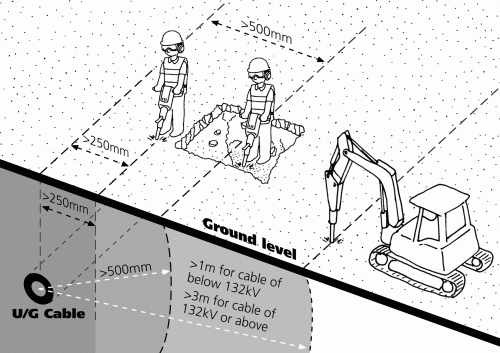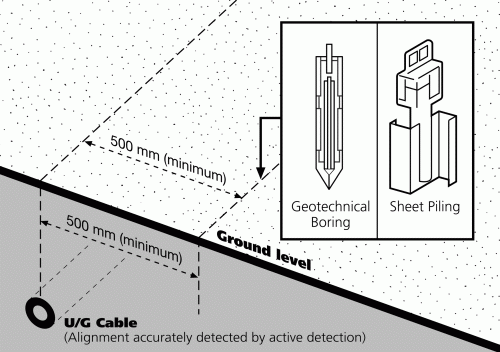<< 3 Reasonable Steps for Working near Underground Electricity
Cables | Table
of Contents | 5 Special Safety Precautions against Damage to Underground
Electricity Cables >>
4 Reasonable Measures for Working near Underground Electricity
Cables
The reasonable measures to a safe system of work for excavation
works near U/G cables encompass the safe use of tools, protections of exposed
U/G cable and safe backfilling practices and include safe working practices
for different excavation methods (hand-held power tool, mechanical excavators,
trenchless methods, horizontal drilling, vertical penetration, use of explosives,
H-piling) or where welding is to be carried out.
4.1 Safe working practices for different types of excavation
4.2 Safe working practices for exposing U/G cables
4.3 Safe backfilling practices
4.4 Safe working practices for trenchless methods/horizontal
drilling
4.5 Safe working practices for vertical penetration
4.6 Safe working practices for other works
4.1 Safe working practices for different types
of excavation
4.1.1 The following general requirements shall be followed:
(a) Other than minor shallow excavation, the electricity supplier shall be
informed before commencing any excavation in the vicinity of U/G cables
of 132kV or above; and
(b) The site personnel should always refer to the Competent Person
Written Report in the course of excavation, and be vigilant for signs
and position of U/G cables.
4.1.2 As the position of excavation by mechanical excavators and hand-held
power tools cannot be precisely controlled in practice, adequate minimum
clearance shall be maintained between any U/G cable and the point where
the equipment is used:
(a) Hand-held power tools – 500mm in any direction from
any U/G cable, except when breaking out paved concrete surface where a horizontal
clearance of 250mm is required;
(b) Mechanical excavators and others – 1m in any direction,
for U/G cables of below 132 kV and 3m for 132 kV or above.

4.1.3 The working party shall consult the electricity supplier
before commencement of works if the required clearance in Section 4.1.2 from
the U/G cable cannot be achieved and keep records. Greater safety clearance
may be required by the electricity supplier or the Director, depending on operating
voltage of the U/G cable and its strategic importance to electricity supplies
in the HKSAR.
4.1.4 Hand tools are commonly used for exposing U/G cables. Every effort shall
be made to excavate alongside the service rather than directly
above it. Final exposure of the service by horizontal digging is recommended
as the force applied to hand tools can be controlled more effectively. In particular:
(a) spades and shovels shall be used rather than other tools.
They should not be thrown or spiked into the ground but eased in with gentle
foot pressure;
(b) picks or forks may be used with care to free lumps of
stone, etc. and to break up hard layers of earth; and
(c) picks should not be used in soft clay or other soft
soils near to U/G cables.
4.1.5 Whenever the excavation involves the removal of hard materials (e.g. concrete,
bitumen and the like) in which the U/G cable is covered or embedded,
the electricity supplier should be consulted before commencement of works.
Back to Top
4.2 Safe working practices for exposing U/G
cables
4.2.1 U/G cables uncovered in an excavation need to be supported.
The electricity supplier should be consulted in advance wherever an excavation
may cause any U/G cable overhanging within the works site.
4.2.2 Collapse of excavation may result in damage to exposed
U/G cables within a trench of depth greater than 1.2m. To protect the U/G cables
and working personnel, it is essential to provide temporary support for the
excavation (e.g. shoring, or timbering or sheet piling, as the case may be)
to ensure the stability of the excavation during works.
Back to Top
4.3 Safe backfilling practices
4.3.1 All warning tapes, tiles, protection plates or other
protection materials shall be reinstated in their original position by the working
party. The electricity supplier should be approached to make up cable protection
materials if they are found to be damaged or missing before the backfilling.
4.3.2 The same backfilling materials should be used unless
otherwise agreed with the electricity supplier. In general, cement
bonded sand11 or sieved soil12
of suitable fineness shall be used as covering material for the backfilling,
as the case may be.
4.3.3 Unsuitable filling materials which are likely to cause
damage or reduce the rating of the U/G cables (e.g. rock, rubble, bituminous
material, brick, stone, timber, rubbish and other materials of high thermal
resistivity) must not be used. If in doubt, the working party should seek advice
from the electricity supplier on the specific backfilling requirements (thickness
of the bedding layer, type of materials to be used and method of compaction,
etc.).
4.3.4 The backfill shall be adequately compacted, particularly
beneath the cable, to prevent any settlement which would subsequently damage
the cable. No power compaction should take place until a 150mm cover of selected
fine fill or sieved soil has been suitably compacted above the U/G cable. Concrete
backfill shall not be used within 300mm of an U/G cable in any direction.
4.3.5 Before backfilling, the electricity supplier shall be notified to allow
it to take appropriate precautionary measures if:
(a) the exposed U/G cable, in particular U/G cable of 132kV or above, need
to be relocated to other position (either depth or alignment); or
(b) the U/G cable is found at a depth less than the minimum cover required
by the Highways Department.
Back to Top
4.4 Safe working practices for trenchless
methods/ horizontal drilling
4.4.1 Trenchless methods are increasingly being used for laying and renovating
cables and pipes, particularly where there is a need to avoid surface disruption.
The most widely used techniques are percussion moling, pipe jacking and auger
boring. Horizontal drilling is also commonly adopted in landslip prevention
works for slope stabilization. The electricity supplier shall be informed
before commencement of works in addition to the necessary consultations
at the planning or design stage.
4.4.2 The reasonable steps shall be followed to ascertain both the alignment
and depth of the existing U/G cables, unless advised otherwise by the electricity
supplier. As a general guide, the minimum clearance between
the path of the drilling/boring device and the adjacent U/G cables shall be
of at least 1m in any direction. This clearance may need to
be varied, taking into account the electricity supplier’s advice and other factors
such as the construction of adjacent plant, ground conditions, bore diameter,
the accuracy and reliability of the device being used.
4.4.3 When the path of moling or pipe jacking comes too close to adjacent U/G
cables, extreme care must be taken to avoid cable damage by soil displacement.
A mole tracking device shall be used if the working party finds that the moles
are prone to deflection from their original course.
Back to Top
4.5 Safe working practices for vertical penetration
4.5.1 Vertical penetration works such as sheet piling or geotechnical
investigation are common causes of U/G cable damage at construction sites. The
reasonable steps shall be followed to ascertain the alignment of the existing
U/G cables by toroidal active detection. If there is genuine difficulty in locating
the U/G cables in the vicinity of the works site, assistance should be sought
from the electricity supplier.
4.5.2 A 500mm minimum safe working distance shall be maintained
between the point of vertical penetration and the ascertained alignment of any
U/G cable.

Back to Top
4.6 Safe working practices for other works
4.6.1 Where explosives are to be used within 60m of an U/G
cable, or where H-piling, vertical boring for building structure,
etc. are to be carried out within 15m of an U/G cable, protective measures should
be agreed with the electricity supplier before any works take place.
4.6.2 If welding or other hot works are to be carried out
within 10m of exposed U/G cables, the working party shall take necessary safety
precautions to avoid damage by heat, sparks or naked flames to the protective
coatings and sheaths of the U/G cables. If the welding or hot works are in the
close proximity of the exposed U/G cables, the working party shall consult the
electricity supplier on any special protective measures required.
Back to Top
11 1:14:2 cement bonded sand is defined
as a machine mixed material consisting of 1 part cement and 14 parts sieved
sand and 2 parts water by weight. Sieved sand is defined as washed sand passing
through a 5mm x 5mm mesh screen. [Go Back]
12 Sieved soil is defined as soil of
suitably low thermal resistivity passing through a 12mm x 12mm mesh screen.
[Go Back]
Back to Top

